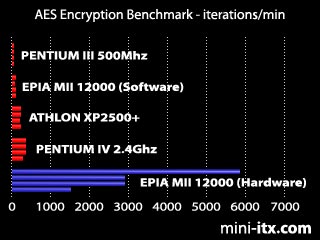 The Advanced Encryption Standard
The Advanced Encryption Standard
The Advanced Encryption Standard (AES) cipher is used in many cryptographic protocols, including TLS (SSL), SSH, & IPSEC. No successful attacks against AES have ever been recognised. Since June 2003, the US Government has used AES for classified information.
ViewTouch POS computers have VIA C5P processors which, unlike standard x86 CPUS from Intel & AMD which can only encrypt or decrypt an AES cipher in software, have hardware encryption/decryption of the AES cipher. VIA's AES Benchmark tool calculates AES speeds and measures the C5P's hardware AES core performance.
The C5P processor at the heart of every ViewTouch POS system has two random bit generators which non-deterministic random numbers from the intrinsically random physical processes occurring in its semiconductor diodes. A Zener diode operated in a special circuit derives an abruptly changing current from a process called "voltage breakdown". This is an erratic process which is governed by laws of Quantum Physics and is therefore genuinely random in nature. The phenomenon produces a small voltage variation across the diode which is extracted via AC coupling and is amplified to achieve a large amplitude noise which is used to control a logic digitisation circuit which, upon request, produces either 0 (logic zero) or 1 (logic one) as its output.
Heady? Absolutely. We only mention it because when we tout ViewTouch as a POS solution with a perfect record of security, and with the confidence that it will always remain secure, we are obligated by our own sense of ethics to explain the how and the why of it.
|
|
The C5P has an ace up its sleeve; it can do the calculations in hardware. When the C5P's AES hardware was invoked the graph had to be rescaled by 2 orders of magnitude to illustrate the result. In one minute, 5876 ECB iterations, 2900 CBC & CFB iterations and 1480 OFB iterations were obtained. The nearest competitor, the 2.4Ghz Pentium IV, managed only 368 iterations on its fastest test. The C5P was from 6 to 17 times faster than even the Pentium IV on every test !!
